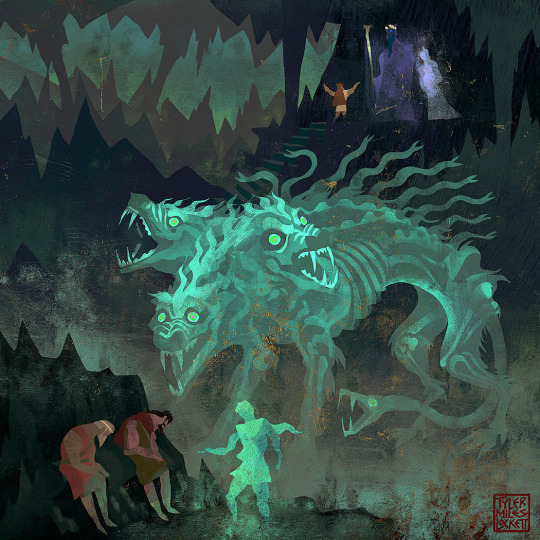#tylermileslockett
Text

Chthonic Descent (#4 in my Orpheus and Eurydice series)
The Roman poet Virgil, in his poem “Georgics”, gives a lush description of Orpheus descent into Hades;
“…entering the grove gloomy with black horror, he approached the Manes (dead spirits), and the tremendous king, and the hearts that know not how to relent at human prayers. But the thin shades being stirred up by his song from the lowest mansions of Erebus moved along, and the Ghosts deprived of light… mothers and husbands, and the departed bodies of magnanimous heroes, boys and unmarried girls, and youths laid on funeral pyres before the faces of their parents, whom the black mud and squalid reeds of Cocytus, and the lake hateful with stagnant water encloses around, and styx nine times interfused restrains.” (-translation from the Latin by John Martyn.)
The word Chthonic in my title is an adjective describing something belonging to the underworld. This would be an apt time to discuss the structure and details of the ancient Greek underworld; the realm of Hades. Our oldest literary source in Homer’s “Odyssey” (700 B.C.) portrays the realm as dark, gloomy, and frightening. A place where all souls go, and lacking skin and bone; have no physical form. The shades (spirits) wander mindless, and without memory.
In Virgil’s “Aeneid” (25 B.C.) we get a much more detailed account of the geography. Our hero Aeneas pays the boatman Charon to ferry him across the river styx, and after passing the three headed guard-hound Cerberus, they eventually come to a crossroad leading to two important realms; Tartarus (an invincible fortress guarded by one of the Furies, where sinners are punished) and Elysium (a sunny paradise where pure souls pursue leisure activities).
As always thanks for looking and reading. Please share this post and I'll toss charon a coin for you. Xoxo
Like this art? It will be in my illustrated book with over 130 other full page illustrations coming in march to kickstarter. Please check my links in my linktree in my bio to join the kickstarter notification page. 🤟❤️🏛
#hades#orpheus#persephone#underworld#eurydice#pjo#percyjacksonandtheolympians#percyjackson#greekgods#furies#tartarus#elysium#ancientgreece#ovid#virgil#tylermileslockett#charon#riverstyx#cerberus#loreolympus#Orpheus#Hades
150 notes
·
View notes
Text
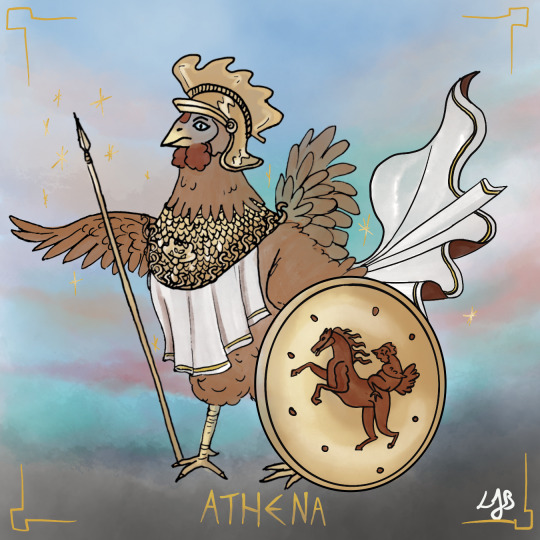
A very rushed little At-HEN-a rework to take part in @tylermileslockett ‘ #DTIYS - I adore his Athena artwork! Done in the middle of the night while I couldn’t sleep (we have the lurgy in our house)

Experimenting with Procreate colour here - I normally colour in Photoshop with my favourite watercolour brushes (from True Grit Texture) but thought I’d mess about with the watercolour brushes included. They’re not bad, especially the big splashy ones! Very different from Tyler’s dry-brush textured (and non-lined) style, but that’s what makes him so unique!
If you love Tyler’s artwork like I do (former Guest Post on GMC) then look out for his book this year! ❤️
#greek mythology#tagamemnon#greek myth#illustration#athene#athena#at-hen-a#greek myth chickens#dtiys
146 notes
·
View notes
Text

sorry to my ancestors that I drew this to a viral tiktok sound and not Greek music
Athena for #dtiys contest for @tylermileslockett #tylermileslockett . Athena is the Greek goddess of wisdom, military strategy, state building, and patron of Athens -- the myth goes she beat out Poseidon for the honor by inventing the olive tree. She's traditionally depicted with a spear and shield, engraved with horse and rider, and Medusa's head on the front of her breastplate. Unfortunately I didn't have time to draw Medusa, and also feel Medusa got a very raw deal there. What I did choose to depict from the original is her sacred animals, the owl (representing wisdom) and the snake (representing the first ruler of Athens, Erichthonius). Both creatures are Greek species here, a small owl and a whip snake.
I grew up on the legends of Athena as bedtime stories. Most notably she sprung forth from her father Zeus's head by splitting it with an axe. May all Mediterranean women give our dads a bit of a headache 🥴
#illustration#art#trigger warning owl#tw owl#owl#snake#athena#my doodles#procreate#my art#character design#dtyis#pencil#greek mythology#Spotify
51 notes
·
View notes
Text

Athena always watches over us.
@tylermileslockett 's contest entry but unfortunately I didn't have time to color it over for the contest, hopefully this one should suffice. I'm just happy that I'm able to participate.
#greek mythology#hellenistic#greek gods#greek posts#my art#greek-bros#history#ancient greek#personal#Athena#athens#bubo#character development#character designs#tyler miles lockett
26 notes
·
View notes
Text
A Fucking Break in Fucking Hell
Recently I've been learning a few new details about the Orpheus and Eurydice myth, and there's one detail I can't get over currently: When Orpheus arrives in the underworld in the hopes of getting back his recently-deceased love Eurydice, he sings a song so heartbreakingly beautiful that everyone pauses for a moment. As Ovid put it in his Metamorphoses (translation by Brookes More, 1922):
Thus, while the bard melodiously complains,
And to his lyre accords his vocal strains,
The very bloodless shades attention keep,
And silent seem compassionate to weep;
Ev’n Tantalus his flood unthirsty views,
Nor flies the stream, nor he the stream pursues,
Ixion’s wondering wheel its whirl suspends,
And the voracious vulture, charm’d, attends;
No more the Belides their toil bemoan,
And Sisyphus, reclined, sits listening on his stone.
What I can't get over with here is that Tartarus, the ancient Greek version of hell, in my eyes is a place that's more or less completely about never having a break. All its inmates suffer without rest by having to do the same shit over and over again. Like Tantalus, who hungers for fruit always just a bit out of his reach. Or Tityus, who gets his liver eaten by vultures, again and again. And of course Sisyphus and that fucking stone that always rolls back.
And then there is Orpheus who comes down there and sings. And for the sweetest of moments, everyone at this "Gimme a break, darnit!" hellscape of a place. Have. A. Fucking. Break.
I guess this gets me because it really is a powerful move to show what a darn marvellous musician Orpheus is. And maybe I find my work a bit never-ending, too, from time to time. So yeah, can relate.
But enough of me. For a more pleasing conclusion of this little rambling, please have a look at this marvellous depiction of Orpheus' gig at Tartarus by @tylermileslockett:
#i was not emotionally prepared for this#greek myth#orpheus#eurydice#tartarus#afterlife#too much work#need a break#need a fucking break#schroed's thoughts
1 note
·
View note
Text
Athena
Follow the artist on Instagram: https://instagram.com/tylermileslockett

1 note
·
View note
Text

"The Gate to Hades" (part 3 in my Orpheus and Eurydice series)
Part3: But Orpheus is not satisfied to sit in solitary mourning. There was a great injustice in the death of his love Eurydice. If the beasts and rocks of the wild woods of Olympia bow before his song, what is to stop him for persuading the spirits of the underworld? Perhaps he can even persuade the King Hades to take pity on him and his lost love. With this determination, he receives directions to the dark gate from the forest nymphs and sets out. Many days later, standing before that gaping black maw, Orpheus shivers. He might never return to the land of the living. He steps forward. He has nothing left to lose.
In Greek literary sources we have varying references to the location of the entrance to underworld. In Homer’s Odyssey, Odysseus must travel to Hades to perform a “Nekyia” ceremony to commune with the dead to receive prophecies. Circe gives Odysseus the vaguest of directions; “…once your ship has crossed flowing Ocean, drag it ashore at Persephone’s groves, on the level beach where tall poplars grow, willows shed their fruit, right beside deep swirling Oceanus. Then you must go to Hades’ murky home, where Periphlegethon and Cocytus, a stream which branches off theriver Styx, flow into Acheron.” – translation by Ian Johnston.
Some scholars believe Homer’s description of the location is based on the real-world temple of the “Nekromanteion” (oracle of the dead) in Ancient Epirus (Northwest Greece). This was a temple of necromancy dedicated to Hades and Persephone where devotees could commune with dead spirits, and was believed to be the entrance to Hades. The temple was located at the meeting point of three rivers; the Acheron (river of woe), Pyriphlegethon (river of fire), and Cocytus (river of lamentation).
Thanks for reading and looking! If you share this image I'll swim the river styx to.give you a high five! Xoxo
Like this art? It will be in my illustrated book with over 130 other full page illustrations coming in march to kickstarter. Please check my links in my linktree in my bio to join the kickstarter notification page. 🤟❤️🏛
#percyjacksonfanart#percyjackson#orpheus#eurydice#percyjacksonandtheolympians#darkacademia#orpheusandeurydice#apollo#lyre#bard#ancientbard#orphic#classicliterature#classicnovels#tylermileslockett#greekmyths#greekgods#truegrittexturesupply
107 notes
·
View notes
Text

An Impossible Task (#3 in my "Quest for the Gorgon Head" series
Perseus was lovingly raised into a fine young man by the fisherman who found them. Amazingly, the fisherman’s brother was King Polydectes, the ruler of Seriphos. One evening Perseus is invited to a secret banquet within the king’s hall. It is revealed the party is for guests to offer gifts to the king for a dowry to marry a neighboring princess. Many aristocrats lead fine horses before the king in generous offerings, until finally, Perseus is called up to present his contribution. The boy, unprepared, stands empty handed. Eager to prove his worth, the young man offers to acquire anything the king wishes, even “the Head of a dreaded gorgon”, he jokingly adds. The hall echoes in chuckles. But the king does not laugh. For king Polydectes, secretly desiring Perseus’ mother Danae, has cleverly devised this trap to dispose of the boy. The king immediately agrees to Perseus’ impossible suggestion. Perseus, keeping his composure, gracefully bows and retires. But how on earth can he ever hope to accomplish such an unimaginable task? He will need help. Help from the gods.
Here we have an example of what Joseph Campbell deems the “Call to adventure.” This is the point in a myth or fairytale where the protagonist is either offered or forced into a quest. Sometimes the hero will turn down the call, but in the end, the journey must commence, or else we have no story.
Like this art? It will be in my illustrated book with over 130 other full page illustrations coming in June to kickstarter. to get unseen free hi-hes art subscribe to my email newsletter
Follow my backerkit kickstarter notification page.
Thank you for supporting independent artists! 🤘❤️🏛😁
#greekmythology#greekgods#pjo#mythology#classics#classicscommunity#myths#ancientgreece#danae#perseus#medusa#gorgon#percyjacksonfanart#percyjackson#percyjacksonandtheolympians#darkacademia#classicliterature#classicnovels#tylermileslockett#greekmyths#darkmyths#darkfairytales
59 notes
·
View notes
Text

"The Death of Eurydice" (#2 in my Orpheus and Eurydice series)
But the three Moirai (fates) weave and cut their strings of mortal’s destinies, and this love was not destined to last. Dancing barefoot upon the forest floor with the nymphs, Eurydice was bitten by a venomous snake and tragically died. Orpheus played such music of melancholy mourning as to make the trees bow and weep.
The Latin poet Virgil gives a lush description of lament from his poem, “Georgicks:”…“But the choir of sister Dryads filled the tops of the mountains with their cries: the rooks of Rhodope wept, and high Pangaea, and the martial land of Rhesus, and the Getae, and Hebrus, and Attic Orithyia. He assuaging his love-sick mind with his hollow lyre, lamented thee, sweet wife, thee on the solitary shore, thee when day approached, thee when it disappeared.” (-translated by John Martyn.)
We have multiple sources giving variations recounting Eurydice’s death. According to Ovid, she was walking along the riverside with her sister dryad nymphs, while Vergil has her escaping a rape attempt by another son of Apollo; a pastoral god named Aristaeus. But the authors agree that her death results from the bite of a poisonous viper.
As always, thanks for looking! And if you could share this post with your followers I'd be so grateful as to rescue you from the pits of tartarus with only my lyre. :D xoxo
we should also add this kickstarter info at the end of every post:
Like this art? It will be in my illustrated book with over 130 other full page illustrations coming in march to kickstarter. Please check my links in my linktree in my bio to join the kickstarter notification page. 🤟❤️🏛
#percyjacksonfanart#percyjackson#orpheus#eurydice#percyjacksonandtheolympians#darkacademia#orpheusandeurydice#apollo#lyre#bard#ancientbard#orphic#classicliterature#classicnovels#tylermileslockett#greekmyths#greekgods#truegrittexturesupply
120 notes
·
View notes
Text
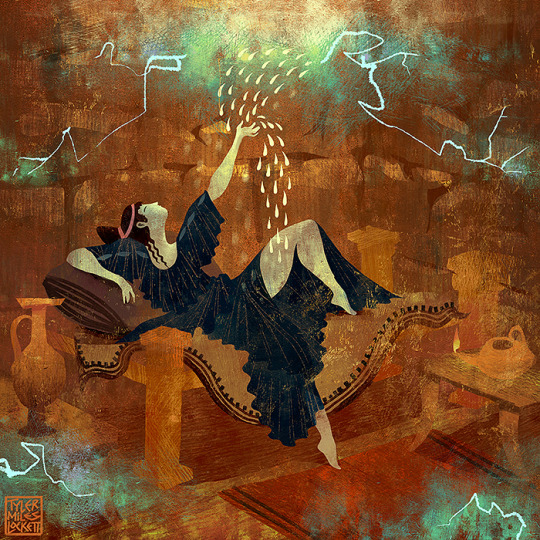
The Seduction of Danae, (#1 in my "Quest for the Gorgon Head" series)
King Akrisios of Argos receives an ominous warning from the oracle that his daughter, Danae, will give birth to a child that will slay the king. These pesky father slaying prophecies pop up again and again in Greek myth; Cronus being overthrown by his son (Zeus) and Zeus in turn being overthrown by his offspring with Metis.
So what does our King Akriosis do with his daughter? Well, he imprisons her into an underground Bronze chamber of course! keeping her and her womb far from any pesky suitor's libidos. But Zeus, visits Danae, and morphs into a gaseous cloud, penetrating into the cracks of the chamber, seducing Danae with warmth and wonder, pouring his favor upon her in the form of a golden rain. The symbolism is clear here, as rain fertilizing crops is standard symbolism for intercourse in Greek erotic poetry.
There is much debate through a modern lens at Zeus's conquests; is he raping or seducing? Well, He, and many other gods, do both. In certain tales, they seduce the willing, and in others, they rape the unwilling. With Danae, it was left open to my artistic interpretation. I decided that Danae, having been chained in a bronze dungeon cell by her own father, in her isolation and confinement, welcomes the deity and a child into her womb as a miracle. But when Danae gives birth to her son, a little boy she names Perseus, the King has a cruel plan for them both.
Like this art? It will be in my illustrated book with over 130 other full page illustrations coming in June to kickstarter. to get unseen free hi-hes art subscribe to my email newsletter
Follow my backerkit kickstarter notification page.
Thank you for supporting independent artists! 🤘❤️🏛😁
#greekmythology#greekgods#pjo#mythology#classics#classicscommunity#myths#ancientgreece#classicliterature#classicnovels#tylermileslockett
61 notes
·
View notes
Text
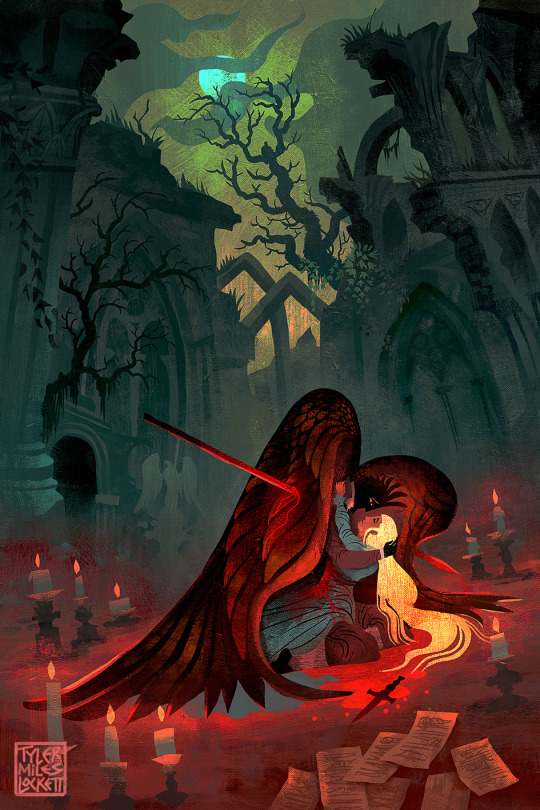
Hey everyone, this was an image i did for an annual illustration competition over at @foliosociety, an amazing design and publishing studio in London which does incredible special editions of notable books with top illustrators. Unfortunately my image didn't place within the top 20, but if you take a look at the longlist youll see the competition was fierce this year! I'll try again next year.
We were asked to illustrate a scene from the short story, "The Flyers of Gy" by Ursula K. Le Guin about a humanoid society that sometimes develop wings and risk their lives to fly.
The image I chose to create was from a scene in the story explaining one of the tragic plays that came out of that culture. I figured this would be a chance to do some high drama and gothic romance atmosphere. I worked really hard on it, and ill be throwing up some process videos this week.
Thanks for looking! xoxo
#gothicromance#gothic#romanticism#tragedyplay#classicliterature#ursulakleguin#classicscommunity#illustration#tylermileslockett#fantasyart#fantasyillustration#stageplay#Shakespeare#shakespearean
213 notes
·
View notes
Text
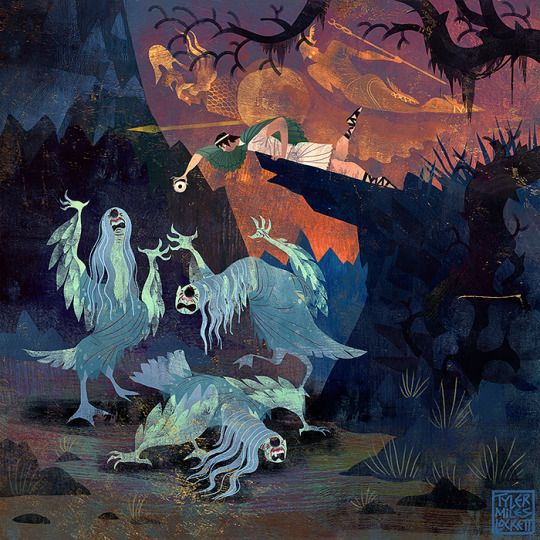
The Sisters Graeae (#4 in my "Quest firnthe Gorgon Head" series)
As Perseus was the son of Zeus, the gods heard his prayers. Athena answered, offering strategic information on the only ones who knew the locations of the The Gorgon sisters, were in fact, another set of three sisters; the sisters Graeae. These are three gray haired old hags with swan like bodies, who share but one eye and tooth between them. Hermes, God of travelers and ally to mortals, also offered his guidance to the distant realm. After many weeks of difficult trekking, Perseus found himself on the island of Cisthene, in the craggy land of the sisters Graeae. Sneaking upon the women, he waited until they passed their one eye between them, snatching it away, and threatening to heave it into the sea. The Graeae gave in, revealing the location of the Gorgon sisters. But it would be no easy task. The gorgon sisters had golden wings, bronze hands, snakes for hair, and worst of all, their gazes turned men to stone. Perseus would need sacred weapons for such a mission. And, according to Athena, there was only one group who could provide them: the sea nymphs.
With the 3 sisters we can see the first of many examples of the “triple goddess” archetype in Old world mythology. Some are represented with one body and three forms (triple bodied Hekate) while most are three individuals. (i.e. “The Morai” (fates), “the Horai” (seasons) “The Furies,” “The Hesperides,”(graces) and “the Gorgons.”) We can see other examples from other ancient cultures, like the Norse “Norns” or the Christian holy trinity of the father, son, and holy spirit. Even Shakespeare, a student of Greek myth and poetry, chose three witches to prophecy to Macbeth.
Like this art? It will be in my illustrated book with over 130 other full page illustrations coming in June to kickstarter. to get unseen free hi-hes art subscribe to my email newsletter
Follow my backerkit kickstarter notification page.
Thank you for supporting independent artists! 🤘❤️🏛😁
#greekmythology#greekgods#pjo#mythology#classics#classicscommunity#myths#ancientgreece#danae#perseus#medusa#gorgon#classicliterature#classicnovels#tylermileslockett#greekmyths#darkmyths#darkfairytales
50 notes
·
View notes
Text

ARGONAUTICA series 6: "Harpies and the Clashing Rocks"
Book 2 begins with the crew docking upon the coast of the Bebrykians, where king Amykos, with outrageous arrogance, challenges the best argonaut to a brutal boxing match. Polydeuks (son of Zeus, and twin half-brother to Castor) rises to meet the challenge. The men wrap their fists with dried leather thongs, and rush headlong into fierce combat. The warriors exchange brutal blows until finally, Polydeukes sizing up the kings weaknesses, delivers the fatal blow, shattering the bones in the kings head. The warriors on both sides rush into battle, the argonauts fighting like wild wolves, and the Bebrykians finally scattering like bees from smoke.
The following day the Argo sails out through the Bosporos strait where the ship Helmsman, Tiphys, overcomes a giant wave. Here they put in at the Thynian coast where they meet the pitiful King Phineus, who had been given the power of prophecy by Apollo. But having revealed too much truth to mankind, Zeus cursed the king, taking away his eyesight, lengthening his lifespan, and ever hounded by the terrifying Harpies,(half-bird half-human creatures) that descend from the clouds to steal the kings food as he eats, leaving behind a rank odor that spoils everyones appetites. Here the argonaut twin heroes Zetes and Kalais, (twin sons of Boreas, the North wind) with their black wings on their temples and feet, flew after the harpies chasing them away forever, thus saving the king from his curse.
In appreciation, Phineus warns the men of the deadly passage through the dark, clashing rocks, advising them to send a dove through first, to test the timing. The following day the men journey through the clashing rocks, using the dove, and with Athena’s aid, barely escape death.
Like this art? It will be in my illustrated book with over 130 other full page illustrations coming in march to kickstarter. Please check my links in my linktree in my bio to join the kickstarter notification page. 🤟❤️🏛
#percyjacksonfanart#percyjackson#orpheus#eurydice#percyjacksonandtheolympians#darkacademia#orpheusandeurydice#apollo#lyre#bard#ancientbard#orphic#classicliterature#classicnovels#aegis#tylermileslockett#greekmyths#greekgods#greekmythology#darkfairytales
56 notes
·
View notes
Text
"The Gate to Hades" (part 3 in my Orpheus and Eurydice series)
Part3: But Orpheus is not satisfied to sit in solitary mourning. There was a great injustice in the death of his love Eurydice. If the beasts and rocks of the wild woods of Olympia bow before his song, what is to stop him for persuading the spirits of the underworld? Perhaps he can even persuade the King Hades to take pity on him and his lost love. With this determination, he receives directions to the dark gate from the forest nymphs and sets out. Many days later, standing before that gaping black maw, Orpheus shivers. He might never return to the land of the living. He steps forward. He has nothing left to lose.
In Greek literary sources we have varying references to the location of the entrance to underworld. In Homer’s Odyssey, Odysseus must travel to Hades to perform a “Nekyia” ceremony to commune with the dead to receive prophecies. Circe gives Odysseus the vaguest of directions; “…once your ship has crossed flowing Ocean, drag it ashore at Persephone’s groves, on the level beach where tall poplars grow, willows shed their fruit, right beside deep swirling Oceanus. Then you must go to Hades’ murky home, where Periphlegethon and Cocytus, a stream which branches off theriver Styx, flow into Acheron.” – translation by Ian Johnston.
Some scholars believe Homer’s description of the location is based on the real-world temple of the “Nekromanteion” (oracle of the dead) in Ancient Epirus (Northwest Greece). This was a temple of necromancy dedicated to Hades and Persephone where devotees could commune with dead spirits, and was believed to be the entrance to Hades. The temple was located at the meeting point of three rivers; the Acheron (river of woe), Pyriphlegethon (river of fire), and Cocytus (river of lamentation).
Thanks for reading and looking! If you share this image I'll swim the river styx to.give you a high five! Xoxo
Like this art? It will be in my illustrated book with over 130 other full page illustrations coming in march to kickstarter. Please check my links in my linktree in my bio to join the kickstarter notification page. 🤟❤️🏛
#percyjacksonfanart#percyjackson#orpheus#eurydice#percyjacksonandtheolympians#darkacademia#orpheusandeurydice#apollo#lyre#bard#ancientbard#orphic#classicliterature#classicnovels#tylermileslockett#greekmyths#greekgods#truegrittexturesupply
41 notes
·
View notes
Text
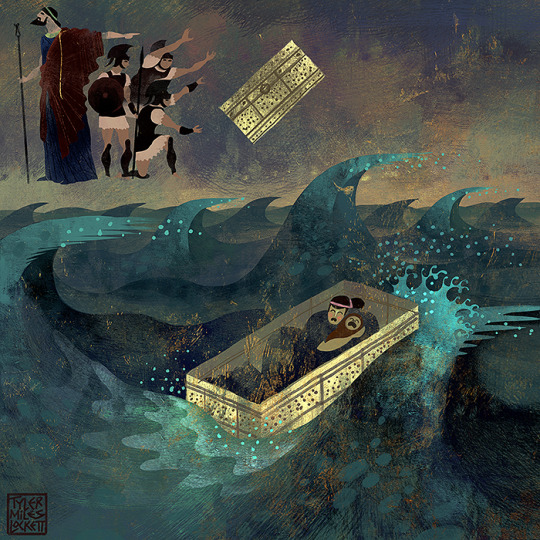
Castaways (#2 in my Quest for the Gorgon head series)
After the miracualous conception, Danae gives birth to a demi-god son she names Perseus. King Akrisios, not believing the child to have been born of Zeus, and to punish her, places her and the child into a chest and casts them into the sea. the pair find safe passage to the shore of Seriphos. Here they are rescued upon the coast by a fisherman, Diktys, who raises Perseus. But Diktys brother is king Polydektes, who, becoming enamoured with Danae, seeks to remove the protective Perseus from his path of desire.
What I find fascinating about this plot point is it being an early example of the "child surviving sure death to fulfill destiny as the chosen one" archetype. From the Book of Exodus (600 B.C.) we have a similar structure of abandonment, rescue from water, and adoption by royalty. In Ancient Egypt, the Pharaoh ordered the slaughter of Israelite children, so Moses' mother placed him within a basket, and cast him off into the Nile, to later be discovered and adopted by the Egyptian royal family.
It also brings to mind another similar structure used by Sophocles in his famous tragedy "Oedipus Rex." (429.B.C.) Queen Jocasta, hearing a prophecy that her son will kill his father (her husband) gives the baby away to a shepherd to leave out exposed on a mountain side, but the shepherd saves the baby's life, thus allowing Odepis to live on to fulfill the prophecy. But that's a tale for another time.
Like this art? It will be in my illustrated book with over 130 other full page illustrations coming in June to kickstarter. to get unseen free hi-hes art subscribe to my email newsletter
Follow my backerkit kickstarter notification page.
Thank you for supporting independent artists! 🤘❤️🏛😁
#greekmythology#greekgods#pjo#mythology#classics#classicscommunity#myths#ancientgreece#classicliterature#classicnovels#tylermileslockett#greekmyths
45 notes
·
View notes
